
Dental X-ray — what can it show us?
Dental X-ray is a commonly used diagnostic test in dentistry, which allows to obtain a detailed picture of the structure of teeth, roots and soft tissues of the oral cavity. Thanks to this examination, it is possible to detect not only dental diseases such as caries or pulpitis, but also diseases of the gums, periodontium and other diseases of the oral cavity. X-ray of the teeth is also essential in the planning of orthodontic or implant treatment, allowing precise determination of the structure and dimensions of bones, as well as the location of nerves and blood vessels. Is it worth fearing him?
What are the types of dental x-rays?
In dentistry, several types of X-rays are used, depending on the purpose of the study. Among the most frequently performed are:
- Periapical (point) photo — represents one or more teeth together with the bone on which they are embedded. It allows you to accurately assess the condition of the tooth, root and periapical tissues.
- Panoramic photo — shows a complete picture of the structure of teeth, roots, jaw and mandibular bones, sinuses, temporomandibular joints and soft tissues such as muscles or salivary glands.
- Cephalometric photo — shows the structure of the skull, jaw and mandible, as well as teeth and temporomandibular joints. It makes it possible to assess the development and structure of the face and to plan orthodontic treatment.
- Tomographic image (CBCT) — an advanced examination that allows you to obtain an accurate, three-dimensional image of the structure of teeth, bones and soft tissues of the oral cavity. Used mainly in the planning of implant and surgical treatment.
The choice of the type of examination depends on the individual needs of the patient and the indications of the dentist.
Panoramic photo of teeth
Panoramic photo allows you to get a wide picture of the structure of the teeth and soft tissues of the oral cavity. During the examination, the patient stands in a special machine, and the X-ray machine takes a series of pictures around the head. Thanks to this, we get an image of the entire oral cavity, including teeth, roots, jaw and mandibular bones, sinuses, temporomandibular joints and soft tissues.
This examination is very useful in dental diagnosis, as it allows you to detect not only dental diseases, but also other conditions such as infections, tumors or periodontal diseases. It also enables accurate planning of orthodontic or implant treatment.
Point (periapical) photo of the tooth
Periapical imaging allows you to get a detailed image of one or more teeth along with the bone on which they are embedded. It allows an accurate assessment of the condition of the tooth, root and periapical tissues such as bone, pulp, blood vessels and soft tissues. Thanks to this, caries, cavities, gangrene of the pulp or periodontal diseases can be detected.
This examination is especially useful for diagnosis when there is a suspicion of an invisible disease in a clinical trial or to determine the scope of treatment. It is safe, and the patient receives a minimum dose of radiation.
Cephalometric photo of teeth
Cephalometric imaging makes it possible to obtain an image of the structure of the skull, jaw and lower jaw, as well as teeth and temporomandibular joints. It is mainly used in orthodontic diagnosis and in the planning of surgical treatment or the evaluation of developmental changes in children.
The examination allows to assess the position of the teeth, the shape of the face and detect malocclusion, such as asymmetry of the face or underdevelopment of the jaw or jaw.
3D Computed Tomography (CBCT)
3D computed tomography, also called cone tomography (CBCT), allows you to obtain detailed, three-dimensional images of the teeth, bones and soft tissues of the oral cavity. It allows for an accurate assessment of the condition of the oral cavity and teeth and precise treatment planning, especially in implantology, orthodontics, maxillary surgery, endodontics and periodontology.
Is X-ray examination of teeth reimbursed?
Yes, in Poland dental X-ray examinations are reimbursed by the National Health Fund (NFZ). Patients insured in the National Health Fund, who have a referral from a dentist, can take an X-ray or other X-ray examination free of charge. For more advanced examinations, such as 3D computed tomography, reimbursement is also possible, but this requires prior consultation and medical justification.
How long to wait for the X-ray of the tooth?
The waiting time for the examination depends on the type of photo, the availability of equipment and staff, and the number of patients waiting. For a regular X-ray, you usually wait from a few minutes to several hours. For more complicated examinations, like 3D computed tomography, the waiting time can range from a few days to several weeks.
In private institutions, the waiting time is usually shorter, but the examination is paid.
Is X-ray examination of the tooth harmful?
X-ray studies use ionizing radiation, which in excess can be harmful. However, a single X-ray of the tooth is associated with a very low dose of radiation and does not pose a threat to the patient's health. The principle of ALARA (As Low As Reasonably Achievable) is used, which means using the lowest possible dose of radiation sufficient to obtain the necessary diagnostic information.
For comparison, the annual dose of natural radiation in Poland is about 2.5 mSv, while the dose with a standard X-ray of the tooth is only 0.01—0.05 mSv.
Before performing the examination, the doctor assesses whether it is medically justified and safe for the patient. It is worth informing the dentist about previous radiological examinations in order to avoid unnecessary repetition of photographs.
Summary:
X-ray examinations of teeth are safe, fast and extremely helpful in the diagnosis and planning of dental treatment. Performed in accordance with safety rules and only if medically justified, they do not pose a threat to the health of the patient.
Content author

Dr. Jan Kempa
Dr. Jan Kempa is a passionate dentist who always cares about a good relationship with patients. His positive attitude makes even the most timid patients feel safe. He specializes in implantology and dental surgery, using modern treatment techniques. He is enthusiastic about using his own tissues to rebuild bones before implantation and to cover gum recession. Dr. Kempa always finds the time to listen to the patient and offers individual solutions.

Start treatment already today!
Make an appointment and discover why our patients recommend us to their loved ones. We will take the utmost care of your smile.


